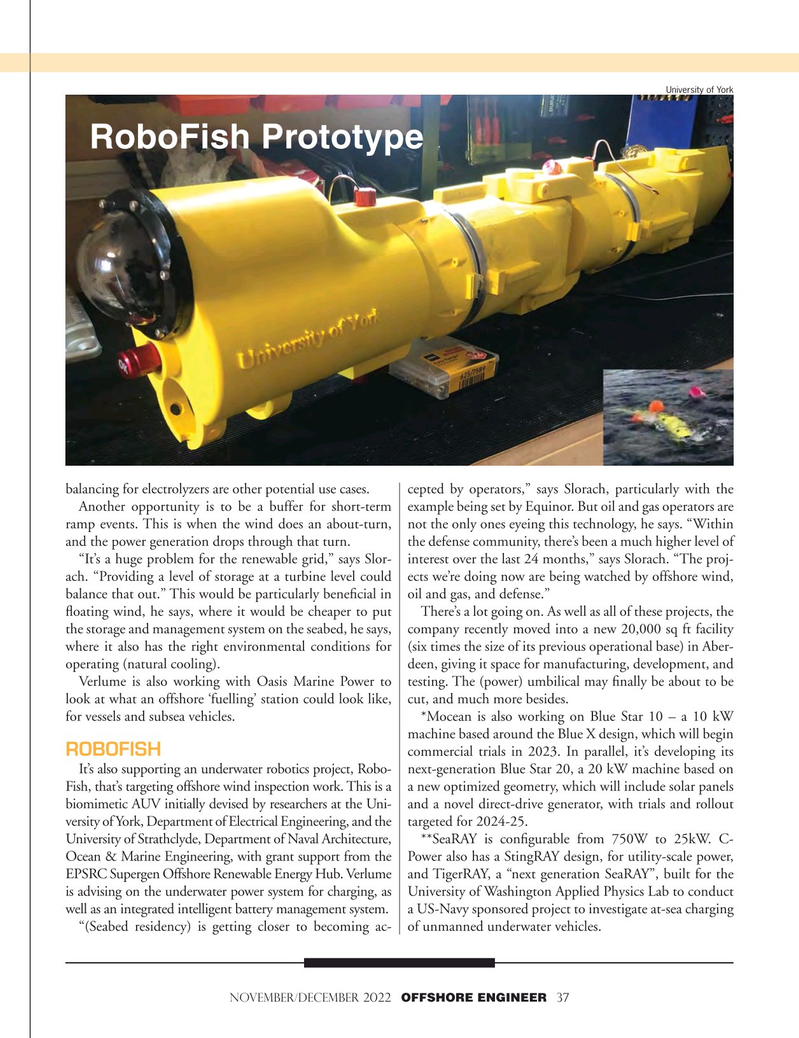
Page 37: of Offshore Engineer Magazine (Nov/Dec 2022)
Read this page in Pdf, Flash or Html5 edition of Nov/Dec 2022 Offshore Engineer Magazine
University of York
RoboFish Prototype balancing for electrolyzers are other potential use cases. cepted by operators,” says Slorach, particularly with the
Another opportunity is to be a buffer for short-term example being set by Equinor. But oil and gas operators are ramp events. This is when the wind does an about-turn, not the only ones eyeing this technology, he says. “Within and the power generation drops through that turn. the defense community, there’s been a much higher level of “It’s a huge problem for the renewable grid,” says Slor- interest over the last 24 months,” says Slorach. “The proj- ach. “Providing a level of storage at a turbine level could ects we’re doing now are being watched by offshore wind, balance that out.” This would be particularly bene?cial in oil and gas, and defense.” ?oating wind, he says, where it would be cheaper to put There’s a lot going on. As well as all of these projects, the the storage and management system on the seabed, he says, company recently moved into a new 20,000 sq ft facility where it also has the right environmental conditions for (six times the size of its previous operational base) in Aber- operating (natural cooling). deen, giving it space for manufacturing, development, and
Verlume is also working with Oasis Marine Power to testing. The (power) umbilical may ?nally be about to be look at what an offshore ‘fuelling’ station could look like, cut, and much more besides. for vessels and subsea vehicles. *Mocean is also working on Blue Star 10 – a 10 kW machine based around the Blue X design, which will begin commercial trials in 2023. In parallel, it’s developing its
ROBOFISH
It’s also supporting an underwater robotics project, Robo- next-generation Blue Star 20, a 20 kW machine based on
Fish, that’s targeting offshore wind inspection work. This is a a new optimized geometry, which will include solar panels biomimetic AUV initially devised by researchers at the Uni- and a novel direct-drive generator, with trials and rollout versity of York, Department of Electrical Engineering, and the targeted for 2024-25.
University of Strathclyde, Department of Naval Architecture, **SeaRAY is con?gurable from 750W to 25kW. C-
Ocean & Marine Engineering, with grant support from the Power also has a StingRAY design, for utility-scale power,
EPSRC Supergen Offshore Renewable Energy Hub. Verlume and TigerRAY, a “next generation SeaRAY”, built for the is advising on the underwater power system for charging, as University of Washington Applied Physics Lab to conduct well as an integrated intelligent battery management system. a US-Navy sponsored project to investigate at-sea charging “(Seabed residency) is getting closer to becoming ac- of unmanned underwater vehicles.
november/december 2022 OFFSHORE ENGINEER 37

 36
36

 38
38